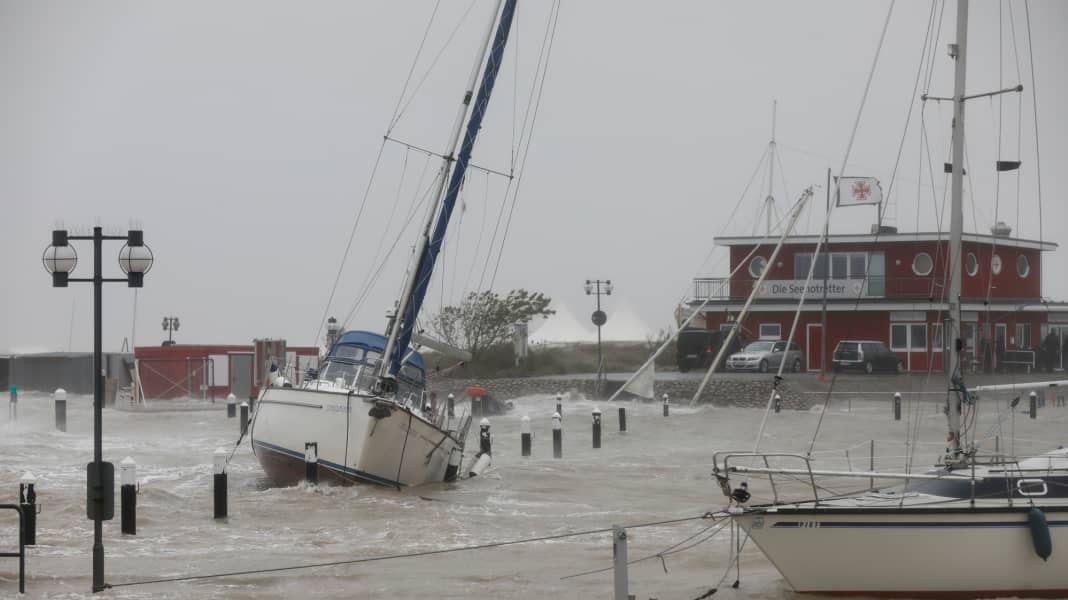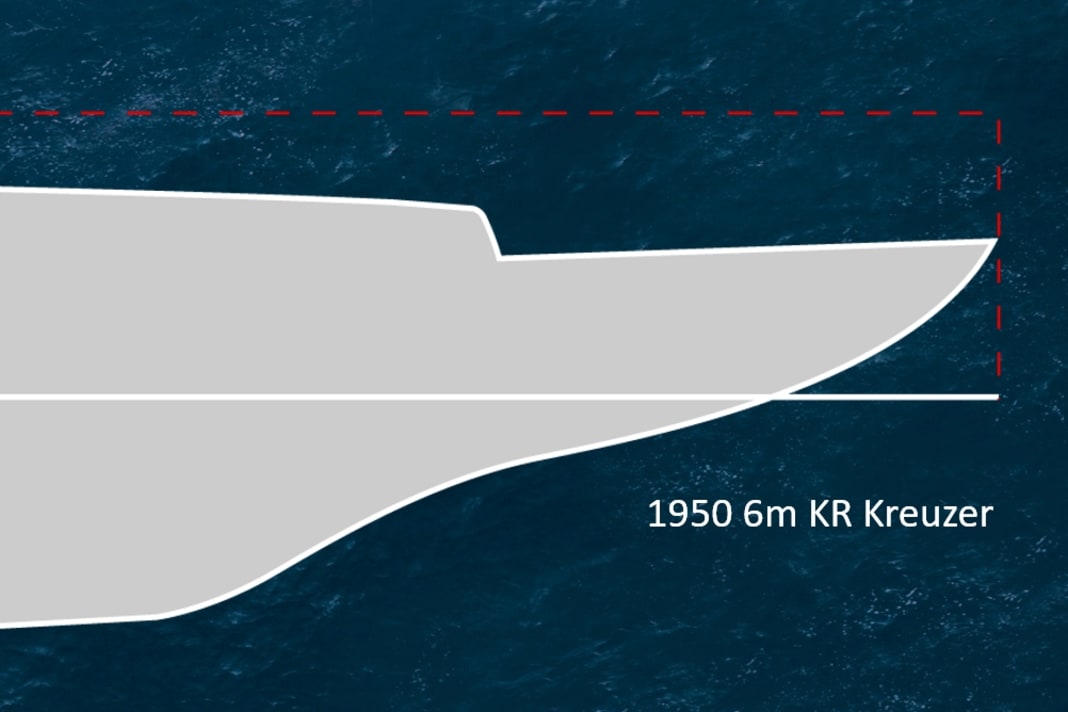
The sinking of so many yachts in the harbour as in the Baltic Sea storm surge required several components. The high water level in combination with waves that ran through some harbours created load peaks on mooring lines and jetties that were often unable to cope. Added to this was the gale-force wind.
The example of a 10-metre yacht shows what it means when a lot of wind hits modern yachts from the side.
Modern yachts have enormous attack surfaces
In recent decades, design development has increasingly focussed on volume above the waterline (see gallery).





If you imagine a square around the projected area, this square is being filled more and more by modern yachts. Because of straight sterns and stems, a lot of freeboard and high and long superstructures.
These offer the wind enormous surfaces to attack. You usually don't notice much of this in moderate conditions, as the wind pressure on these surfaces is also rather low in light winds. However, the pressure on the hull and rig increases in proportion to the square of the wind speed. For example, the difference between three wind forces and nine wind forces does not mean a tripling of the wind pressure, but almost a 21-fold increase.
Wind pressures on an area of one square metre with cw = 1
The rigs also offer more attack surface
In addition to the increasing projected areas, there is another aspect. In rig design, the proportion of sail area is shifting more and more in favour of the mainsail. The masts and main booms are getting longer. Let's assume that the mast of a ten-metre yacht is around 13 metres long. With a profile depth of 25 centimetres, this results in a projected area of 3.3 square metres, which is roughly equivalent to an Opti sail!
There are also headsail furling systems; hardly any cruising sailors do without them these days. With a luff length of around twelve metres and a diameter of only ten centimetres, which is not much, the rolled-up cloth sausage results in a projected area of 1.2 square metres. Or lazy bags: boom length 4.5 metres, height of the bag around 40 centimetres - results in 1.8 square metres. These are also around three metres above the surface of the water, as the large trees are positioned higher than before to allow for spacious sprayhoods.
All in all, an average ten-metre cruising boat offers more than 20 square metres of wind attack surface above the waterline; not even counting stages, shrouds, spreaders, bow or stern pulpits, sprayhoods or even cake stands. At Beaufort 7, this corresponds to 360 kilograms, at rest, not yet accelerated.
However, these almost 360 kilograms do not have to be held completely by the mooring lines because, firstly, the wind does not always come exactly from the side and, secondly, not all surfaces of the projection are vertical.
Nevertheless, the figures clearly show the enormous loads that can be generated by the wind alone. When preparing for storms in the harbour, every square metre that can be taken out of the wind is crucial.
It is not known exactly what loads are generated when it is not only blowing accordingly, but when the yacht, which usually weighs tonnes, presses into the mooring lines with its mass accelerated by the waves. However, it is only logical that they can amount to a multiple of what the wind alone causes.
How much can mooring lines withstand?
Some losses could certainly have been avoided by using better mooring lines. An old sheet or similar is a very poor choice for use as a mooring line. Such lines, which are usually old and stretched out, only have a fraction of their original durability left.
For modern mooring lines, which are specially designed for this purpose, three factors are decisive: the working and breaking load as well as the elongation behaviour. Our rope test provides precise information on this. The 14 millimetre thick mooring lines tested there have a breaking load of over four tonnes for a 10 metre yacht. In practice, however, the breaking load of a mooring line only plays an indirect role, as it is used to derive the working load. According to the recommendations of the classification society DNV GL, it should not exceed 20 per cent of the breaking load, which corresponds to values between 735 and 1,128 decanewtons for the test candidates. Higher working loads offer scope for mechanical damage to the rope.
And once a mooring line has been affected, its breaking load is dramatically reduced, in some cases to less than half in the test.
The more stretch, the more energy absorption
The elongation behaviour is also important. The energy that flows into the cordage to stretch it does not reach the fitting on board or on the jetty. The tested cordage also differed significantly in this respect.
What mooring lines should be able to do
- High elongation: The more energy the line can absorb by changing its length, the softer the ship jerks in, which reduces the load on the cleats and makes the stay on board more comfortable.
- High breaking load: The required breaking load depends on the size of the ship. Even small chafe marks weaken the cordage considerably, so a reserve should be planned in.
- Robust: Rusty iron rings, concrete quays or the lip nozzles with cast iron seams: The list of possible chafe marks is long. The swell and wind mean that the mooring lines are practically always in motion. Only very robust constructions can withstand this constant stress.
- Lehnig: The smoother the line is, the better it can be covered and shot up.
Knots weaken lines
It is well known that knots reduce the strength of the line - but how much does the breaking load decrease? We have investigated the most common knots for joining two lines - each with 10 millimetre thick cordage. With polyester ropes, the core and cover bear almost equal weight. It is therefore not a problem that it is mainly the sheath that pinches in the knot. The situation is different with dyneema ropes, which derive their strength almost exclusively from the very smooth core. If this slips in the knot, too much load is transferred to the sheath - and it breaks.
The bowline often used for mooring lines, for example, reduces the breaking load of the line by 73 per cent!
Don't skimp on mooring lines
Wind and waves can also generate enormous loads on a yacht in the harbour, which must be absorbed by the mooring lines. Even with modern ropes, their breaking load is reduced due to knots or damaged areas. However, there is no need to add up these weakening factors, the mooring line only ever breaks for one of these reasons: undersized, knots present, damaged areas present. Therefore, pay attention to the following with mooring lines:
- it is better to choose a mooring line size higher than recommended for your own yacht
- Deploy as many mooring lines as possible at different attachment points to distribute the loads
- on piles: Secure the mooring line against slipping up the pile with a self-pinching eye

